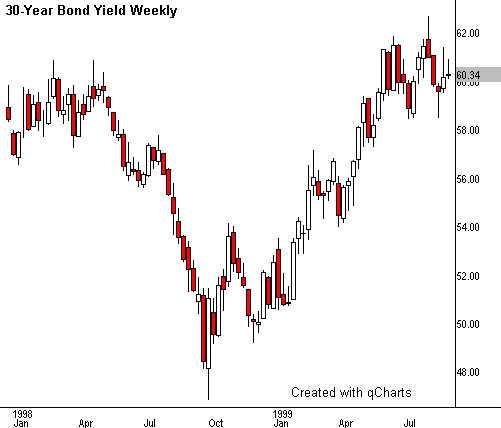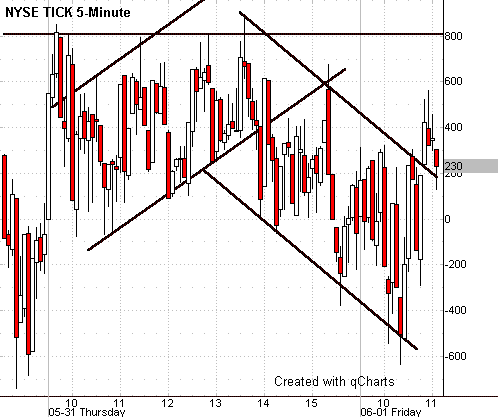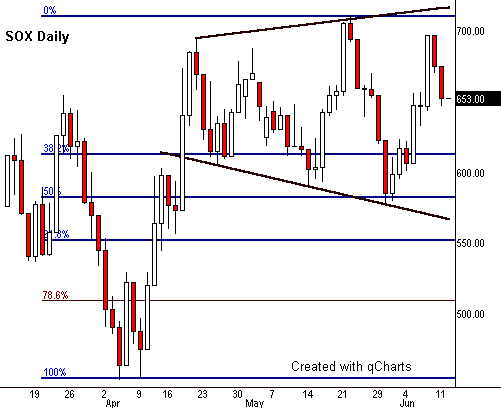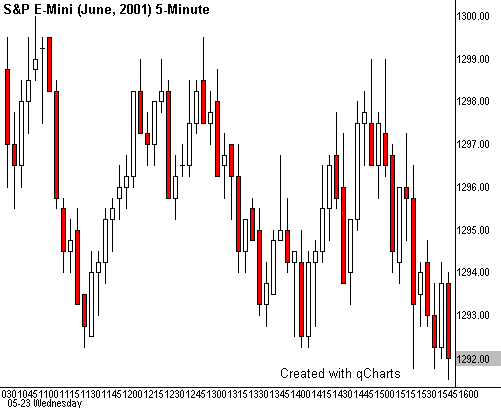Getting An Edge With Cross-Market Analysis
Chart readers fall into two distinct categories
when it comes to cross-market
analysis. The first group focuses solely on the individual price chart becausef
it believes that all market influences lie hidden in the candlesticks of that
single view. The second group doesn’t have quite so much faith in simple price
patterns. It contends that market prediction ties together many unrelated
forces and that their ultimate success or failure depends on how these primary
influences dominate the overall trend during the specific times that their
trades are held.
All in all, this second group has a much firmer grip on trading reality. Most
times, market direction is only as strong as the leadership that guides it.
Individual stocks tend to follow the leader even if their chart patterns carry a
contrary bias. The unfortunate truth is that pretty patterns won’t stop price
from heading in the “wrong” direction when broad market influences
take over.
We tend to migrate toward the single-chart theory because it makes our trade
preparation a lot easier. Why study five or 10 charts when you can look at just
one? We also recognize that trying to interpret cross-markets isn’t child’s
play. It takes a lot of skill to sort out all of the different forces, how they
interact, and which ones will take control at any given point in time.
It’s a Big World, After All
Traders must digest a vast amount of cross-market information to reach simple
conclusions about opportunity and risk. The first thing you need to do is
determine whether local or world conditions will more likely guide the
short-term price action. World conditions take control infrequently, but can
exert a major influence when they do. The Asian meltdown in 1998 offers a great
example of this type of cross-market leadership.
The broad interplay between debt, currencies and commodities can dramatically
affect the US equity markets. These major forces trigger arbitrage between index
futures and debt that can move stock prices quickly. Fortunately, major shifts
between these universal markets tend to occur slowly. You can often prepare for
their impact through a few well-chosen news articles or a weekly index chart
analysis.
Simple arbitrage generates primary influence during quiet periods but broad
issues may rise to the surface at any time and shock American markets. Always
defend active positions by staying informed and planning a safe exit in the case
of an emergency. Avoid overnight holds during very volatile periods and think
contrary at all times. The best trading opportunity may come right after the
crowd jumps for the exits.
Local influences dominate trading considerations most of the time. Stay
informed. Today’s excitement won’t move tomorrow’s markets. Learn to see the big
picture and anticipate leadership through the media hype. Fortunately, markets
have a self-fulfilling mechanism that pushes the most emotional issues right to
the top of the trading heap. Try to identify proxies for these issues in the
indices, futures or even individual stocks that reflect the short-term mood.
The markets constantly seek leadership. In the absence of larger forces, that
role can shift at any time from the S&P futures to the Nasdaq to the Dow-30
Industrials. A major sector, such as semiconductors, can quickly move into the
limelight and carry other markets higher or lower with little warning. These
fluctuations may or may not affect your individual positions but your risk
decreases when you pay attention to the guiding forces at work each day.
 |
| Troubles in Asia and the collapse of LTCM trigger violent movement in the credit markets. Bonds and equities are tied together through a natural inverse relationship. For example, when one goes up, there is a tendency for the other to go down. But it often takes specific market conditions, such as those in 1998, to awaken its great influence. |
TICK Oscillation
TICK measures the transaction flow running through an individual market. The
classic TICK indicator captures in real time the number of stocks whose last
trade represents an uptick vs. a downtick. The NYSE TICK provides a highly
predictive indicator for all American stock activity. Specifically, Nasdaq
traders can avoid that exchange’s TICK information and use the NYSE version
instead to watch the flow of buying and selling within the broader markets.
Follow the TICK through real-time quotes and keep an active chart that
illustrates recent historical activity. TICK routinely forms trendlines and
parallel channels that reveal complex intraday support-resistance. This
oscillating behavior also tends to reverse at recent horizontal extremes that
set natural limits on buying and selling activity. Start TICK analysis by
drawing lines and channels that define the recent action. Then extend these
lines and watch how they align to intraday reversals, breakouts and price
congestion.
TICK identifies natural entry and exit zones. TICK may surge when channels or
trendlines break, and just like individual stocks, it often pulls back quickly
to test new support before the breakout pushes further. Align position entry
with expected TICK behavior. Use oscillating reversals and breakouts as
cross-verification. Also, prepare to terminate a trade without price verification
when TICK flashes important contrary information.
Watch TICK readings at important market turning points. In past years, strong
reversals began when the indicator struck extreme +1000 or -1000 levels. These
natural overbought/oversold boundaries persisted for years. But modern markets
exhibit greater volatility than in the past. TICK readings from +1500 through
-1500 now occur during severe conditions. You can still apply the older limits
when estimating market turns on a relative basis. But always seek
cross-verification through index chart patterns for larger-scale reversals.
 |
| The most effective TICK charts match the nature of the intraday markets. Try five-minute or 15-minute data with two to three days of market action or a 60-minute chart with 5-10 days of history. Use candles in place of price bars. TICK charts print many predictive Doji and Hammer reversals. |
Indices & Sectors
Perform stage analysis on the major indices to identify leaders and laggards.
Are they rangebound or trending? Are oscillators rising or falling? Do they
converge or diverge? Each index has characteristics that affect and distort
daily results. Take the time to learn their construction and how individual
stock movement can generate lopsided information.
Follow those indices and measurements that impact daily decision making.
Nasdaq Composite, Nasdaq-100, SP-500 and the Dow Industrials provide most of the
data required to understand short-term market direction. Apply modern Dow Theory
that looks for convergence/divergence between these four indices. Which is
outperforming and which is underperforming? Keep in mind that an index sitting
near major support or resistance is more likely to draw attention than the one
caught in the middle of its range.
The index leader/laggard relationships define most current market conditions.
When the Nasdaq leads the blue chips up or down, it signals a retail-driven
technology phase with volatile price change. The dominance of the SP-500 or Dow
points to a flight to safety, with big money moving the markets. This often
signals a period of lower volatility and a high probability that a sideways
price pattern will develop.
The Nasdaq has several quirks unfriendly to traders even though it attracts most
retail attention. Three separate sub-sectors comprise this dominant market:
behemoth mega-techs, middle technology/service and a large universe of small
caps. Evaluate Nasdaq price action after inspecting the current performance of
each sub-sector. Frequently, the largest Nasdaq stocks will account for most
price change in the index.
Lethargy in the large-cap stocks may mask small-cap rallies or selloffs.
Mega-techs trade like small indices and often require little external analysis.
But positions in thinner Nasdaq issues can depend on the right sub-sector acting
in a supportive manner. So watch a small-cap index, such as the Russell-2000, in
order to filter out these index distortions.
 |
| Keep one eye on the semiconductor sector at all times. This volatile group leads many Nasdaq selloffs and short-covering rallies, especially when the markets lack direction from other common leadership. |
Futures
The E-Mini contracts for the SP-500 and Nasdaq-100 have expanded retail
awareness of the futures markets. Now many equity traders won’t make short-term
buying or selling decisions without first peeking at these market leaders. Even
longer-term traders often consider the influence of the futures markets before
entering their equity positions. The reason is simple: a sudden futures selloff
will have an immediate impact on stock prices.
Keep futures data on your real-time screen if you are an active trader. Start
by replacing the SP-500 cash quotes with the E-Mini contract. Then add the
Nasdaq-100 E-Mini and watch how most liquid technology stocks respond to its
considerable influence. This interplay reveals a very short time interval in
which you can enter or exit an equity position just before it reacts to the
contract. This can save a substantial loss or add to an already profitable
position.
The futures markets have a higher percentage of professional traders than the
stock markets. This induces a variety of conflicting strategies at almost every
major price level. You can see this conflict on the intraday charts where quick
fading movement follows many wide-range bars. This often gives an odd porcupine
appearance to the flow of price movement.
You can use this phenomenon in two ways when it appears. First, apply it as a
noise filter for execution of equity positions. Real breakouts and breakdowns
will thrust past these fade points, while false moves terminate at them. Pay
close attention and learn to stand aside when others get caught in these small
price ripples. Second, the porcupine fade focuses timing for very short-term
equity scalping strategies. Use the long price bars to signal entry in the
opposite direction. Then watch closely for the fade on the next bar, and exit
the trade into it.
 |
| Sudden price shifts and rangebound conditions often characterize the S&P E-Mini futures contract. Use the short-term reversals to time quick daytrades but always keep an eye out for sudden breakout movement that will ramp the contract to a new price level quickly. |
Alan Farley is a
professional trader and the publisher of the Hard Right Edge https://www.hardrightedge.com
web site, a comprehensive online resource for traders. He is the author of the
best-selling McGraw-Hill release, The Master Swing Trader. Alan has been part of
the market scene for over 14 years as a private investor, advisor and author. In
addition to trading, writing and speaking, Alan has been featured in Barron’s,
Smart Money, Tech Week, MoneyCentral, Bridge Trader, Technical Investor and
TheStreet.com. He has consulted with the major news services on issues facing
today’s online traders and is a strong voice for the Net revolution changing the
face of our modern financial markets.
For The Best Trading
Books, Video Courses and Software To Improve Your Trading
